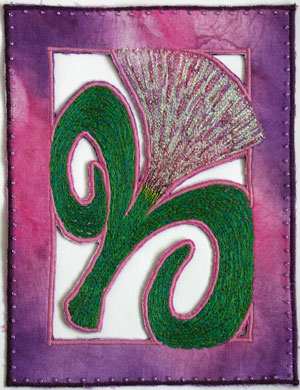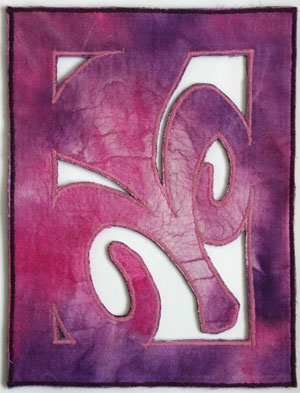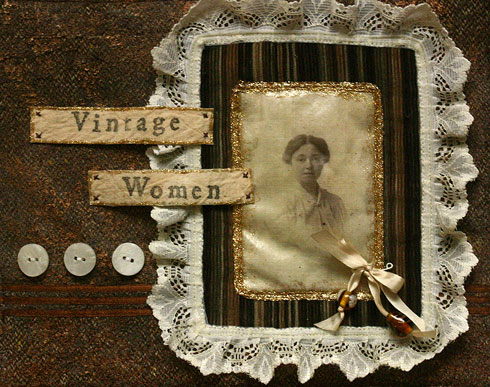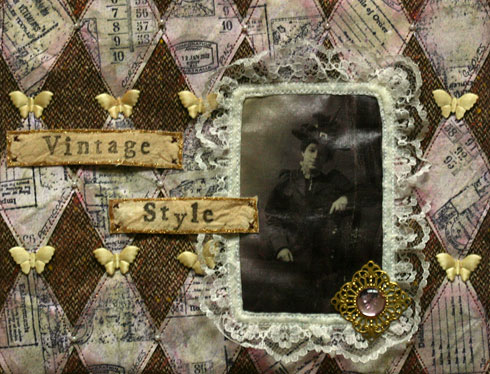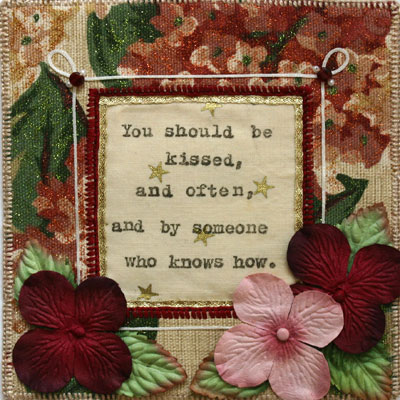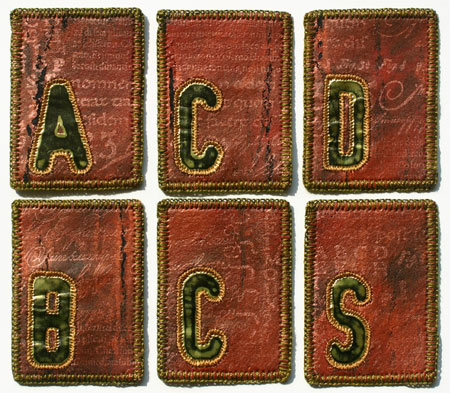Category: Textiles
Articles in the Textiles category
These are the pages I did for Dianne’s book in our Round Robin. She had a theme of ‘Floral Fantasy’, and had done some beautiful stitching on the covers of her book. It was also in a pink and purple theme, so I tried to keep within those parameters.
I started out by painting the fabric. I used Pebeo Setacolour Soleil, but I unfortunately did this on the dark day in history. It was nice and sunny when I started, but unfortunately the sky turned black by the time I finished painting the fabric. I pressed on, and place assorted leaves onto the fabric, and mounted a light over the fabric to help with the sun-dyeing process. What came out was really unexpected. I’m not sure whether it was something about the maple leaves, but the paints didn’t just bleach under the leaves, they actually created tiny waves of colour. I ended up really liking the result, so I plan to try it again in the future, hoping it wasn’t a fluke.
I created a floral design silhouette in much the same way I designed the cover for my own book, where I would be able to cut away parts of the fabrics. I transferred my design on the fabric and mounted the entire thing onto purple felt using bondaweb. I hand stitched the flower and leaves with a variety of threads, including ribbon thread and embroidery floss, then machine stitched over top with coordinating colours or rayon thread. I also added a few beads to the flower itself.
I mounted the back fabric onto the piece and did the edges using a zig zag stitch and all-purpose thread, and the fabric was then cut away. I usually cut first and zig zag after, but in this case I wanted the purple felt to show slightly. I finished the front edge with a few beads around the border.
I hope you like it Dianne! :)

I love dyeing. It’s something I’ve spent many long hours doing, but I don’t have my dyeing equipment with me currently. I wasn’t going to let that stop me from making some customs threads. I started with a few different skeins of threads, including some rayon thread, silk spun and cotton ribbon yarn and used Ranger’s Adirondack ColourWash. I’ve been having a lot of fun with this product ever since I bought it in late summer, it is just so versatile. However, be sure to wear gloves while working with the dye.

To start, I soaked all my threads. I like to unwind them a bit, just because I paranoid about having white bits left over that haven’t dyed. I usually just use tap water, but if you have hard water you may wish to considered using distilled water, and fill a container with the water, immerse the threads, and let them soak for a couple hours (minimum 30 to 40 minutes). Everything seems to dye better if it’s had a good length of time to soak in water first. I’ve used old salsa and dip containers for this because they are a nice size, but any type of container would work although I personally prefer clear containers so I can see through them.

When the fibres have finished soaking, it’s time to create a dye bath. In a separate container, mix some of your ColourWash with a bit of water (if desired). The greater the ratio of dye, the darker the colour will be — straight dye will produce the colour on the package, where as 10 squirts to 1/3 cup of water gave me a lovely light (not pastel) shade. Stir the dye bath. Remove the fibre from the water bath, and give it a gentle squeeze to remove the excess water, and put your fibres in the dye bath, and gently stir. I kept my fibre in the dye bath for a couple of hours, mixing it around occasionally.

Gently squeeze out a bit of the excess dye and hang your fibre up to dry. I used a clothespeg attached to a hanger and hung them off the ironing board because that was what was handy. Be sure to put something under the fibre to catch the drips. The drying time will vary according to weather conditions, and type and amount of fibre, but I generally leave it at least a good day.

To fix your colour, you can either iron it, use a heat gun on it, or heat it in the cooker, however be aware of the melting point for the particular fibre you are using. Personally I like using the iron. You’ll need to iron you fibres at their correct setting for several minutes. Once the fibre has been heat set, wash the fibre out in water to get rid of any excess dye — I personally like using a little bit of shampoo in the water, but soap/shampoo something that is optional, just make sure that the fibres get well washed. Hang them to dry, and once dried they are ready to use.
I like using the ColourWash dyes because they come in a range of wonderful colours, which can be diluted to produce tints, or combined to create even more colours. They are also so easy to use. If you are dyeing just a small amount of thread, such as to use on a paperarts project, you can simply spray the threads with the colour wash, dry, heat set and wash, but for anything more than a couple of yards, I find the above method works quite well, and I will often dye several colours at once.
I had the pleasure of working in Becky’s book in September, in a theme of Vintage women… and I must admit I had fun playing. :)
My biggest challenge was on how to obtain the vintage images for the book, not easy when one doesn’t own a printer. However, my mate Sue had scanned a few of our cabinet cards and printed them off on her laser printer, so I tried to transfer them onto unbleached cotton using Dylon Image Maker. The instructions state that you need to use a photocopy, but I figured since laser printers are toner-based it might work. And it did. :)
I used a brown suiting fabric as the base for both pages, with volume fleece (quilt batting) in between as per Becky’s wishes. On the first page I painted a nappy liner with Adirondack Colour Wash and fused it onto the suiting and zapped it to distress the liner. I then sponged on some metallic copper acrylic paint.
I did a bit of free motion embroidery along the bottom, and stitched down three parallel ribbons for interest. I then used a piece of printed corduroy from a pair of trousers as the frame for the photo, and stitched the corduroy and transfer down with trim. I added a bit of Pebeo Touch paint in gold glitter around the edges of the gold trim to decorate and make double sure the transfer was secured in place (love the adhesive qualities of this stuff).
The labels were some tea-dyed pieces of unbleached cotton left over from another project that were backed with fusing and stamped using Ma Vinci alphabet stamps and then edged them in Touch to prevent fraying.
The second page is made with the same suiting. The diamonds were inspired by Beryl Taylor’s new book Mixed Media Explorations, or at least one of the designs on the cover. I’m soooo asking for this book for Christmas (hint, hint Joey!). I used a piece of 100lb watercolour paper, washed with gouache, stamped it with waterproof ink, spritzed it with Adirondack Colour Wash, washed it, crinkled it, cut it and glittered it with Craf-T glimmer chalks before sewing them down. I then added some sparkle to the suiting using auburn Glitter Touch. The photo and tags were done in the same manner as the previous page, and added a filigree and gem from Mermaid Tears to finish off the page.
I hope you like it Becky!! :)

I finally finished that navy cardigan I’ve been working on for 3 years. Correction—it’s almost done. I still need to block it. It’s nice to finally have it finished, and I like how it fits (even unblocked). It will be nice to wear on those chill winter evenings. :)
This is my page for Sylvia’s book. Her theme was Gone With the Wind quotes, and I liked this quote.
The fabric was supplied by Sylvia and I enhanced it with Pebeo Touch glitter paint to go with her cover piece. The window and edge are bound with blanket stitch, with a thin gold ribbon along the interior edge of the window. The star fabric was supplied by Sylvia, and the quote was stamped with my Ma Vinci using Fabrico stamping ink. The iron-on thread is by Kreinik and was a gift from my mate Jennifer and the flowers were a gift from Anna.
Hope you like it Sylvia! :)

While surfing the web, I came across a few lovely knitting patterns that I’d really like to do and I got really excited until the thought occurred to me that I have a couple of sweaters in progress in the cupboard. So in order to get myself in gear, I’ve promised myself to get these sweaters done and wearable before I start another knitting project.
One sweater is a DK weight navy blue cardigan which only needs to be sewn together and the banding for the centre front & collar done. It’s that close to finishing. The other (pictured) is a plain jumper of acrylic/merino which only had about 4” done on one piece. The back and front are now complete.
Of course, the thing I love about knitting—as opposed to scrapping and paperarts in general—is that I can do it on the commute to work. :)
When my fabric book went out on Thursday (yeah!) I also sent out these ATCs, one for each participant, as a thank you. They are done in the same manner as the Sign-In page, with each personalized with the first initial of each participant, one for myself, and I ended up with an extra simply because I had enough fabric and didn’t want it to go to waste.
Hope you like them ladies! :)
I just finished off the last couple of pages of my fabric book. :)

The page is based on petroglyphs, an ancient form of writing using images. The background fabric is unbleached cotton spray with black Krylon webbing spray and Adrionack colour wash dyes. The paper is 100lb watercolour paper, washed with watercolours, ink and pastels and the petroglyphs were drawn with watercolour crayons. Kokopelli is made of dark brown felt.
The entire page is bound in green loosen weave cotton/linen which was stippled with gold and copper paint, and this page backs the second of the two sign-in pages.
I’ve set up a gallery for this book, which can be found here.

My Sign-In is a two-page spread, with both pages the same except the left page has a title and 2 pockets, while the right page simply has 3 pockets.
To start, I painted some Bondaweb (paper side down) with acrylic paints (burnt umber, indian red and metallic copper) using diagonal brush strokes. Once the paint was dried, I flatten out the bondaweb (keeping the backing paper in place) and put it on a piece of black felt with the Bondaweb paper side up and began ironing the piece from the middle flattening out the fusing as I progressed to the edges.

Don’t worry about and cracks or lines that appear from the Bondaweb transfer as it only adds to the texture of the piece, however do consider the colour of the felt as it does change the effect and look of the piece as it will show through in any cracks and open areas as well as enhance the colour of the paints.
Now the fun begins. :) Using a variety of rubber stamps and a copper Brilliance inkpad, I covered both pages with stampsed images. Do becareful as you stamp as Brilliance is a pigment ink and therefore takes quite a while to dry so becareful not to smudge the stamping. For these pages I used stamps featuring latin text, french script, oriental text, numbers, and alphabets. I tried to cover nearly the entire page without overlapping the images.

Once the images are stamped, grab a heat gun and blast the entire page being sure to be constantly moving the gun. If you are using acrylic felt, as I did, it will melt under the heat gun which will create slight holes in the bondaweb. Be sure not to leave the heat gun in a single spot too long or the felt will melt through and create a hole in the page. The idea is simply to distress the paint layer, not to create lace (at least for this project) as well as to set the ink. :)
With the ink now touch dry, lay a piece of baking parchment over the piece and iron to ensure the ink is fully set. Be sure to use the parchment otherwise the Bondaweb will adhere to the iron or press cloth.

For the title I stamped on gold embossing foil with black Staz-On ink. With a spare pair of scissors (not your best set, please) cut the foil leaving a bit of a margin (about 1/8 to 3/16-inch), tacked the letters to the page with a bit of double-sided tape, and stiched around each of the letters. If you come up through the fabric and down through the metal you will find it easier to stitch and you won’t get accidental holes in the foil.
With the letters stitched, I used a fine embossing stylus and traced around the ouside of the inked edge of the stamped image as it created nice definition and depth, and generally gave a nice finishing touch.
I cut some transparency to fit, and stiched it down to the fabric, creating little pockets as I went. The stitching at the top of the pocket is reinforced with a little inverted triangle. The transparency generally goes to the edge of the page so that its edge is enclosed in the binding.
To finish off the page I backed with the previous/next page and machine basted around the entire piece. Normally I would have used Bondaweb to fuse the pages, however I was worried about discolouring the foil and messing up the painted finish somehow.
I used some lovely brown cotton eyelet to make the binding, cutting from the solid strips rather than the bits with openwork. I then stamped the entire strip with a script stamp and black Versacraft ink, over which I stamped a large bold ‘love’ stamp with copper Brilliance ink, and then stippled metallic gold setacolour over the entire thing. None of the stamping is legible, however the idea was to build up a depth of colour more than anything. Be sure to give the binding a quick blast with the heat gun to get the inks and paints to a touch-dry state, then iron (using baking parchment as a press cloth) to fix. Fold the edges into the middle or use a bias tape folder to create the binding.
After handstiching the binding to both sides, I did a quick beaded running stitch along the ditch. Always remember to knot the thread once in a while just in case the thread breaks, so that in the worst case scenario you’ll lose a few beads rather than the whole lot.
Here’s how the piece looks with my bookmark in place.

I’ve spent the last several days stitching this cover, so I’m quite pleased that it is now in finished form. While stitching I debated on how I wanted to finish my book, and I’ve decided to do it as a coptic bound style (or at least as close as I can get without having actual signatures).
I started out with a piece of natural coloured cotton fabric that has an interesting weave and tea dyed the entire piece. My plans were to do Free Motion Embroidery (FME) on the piece, but wasn’t sure how ‘full’ I was going to end up stitching it. In the end, I ended up covering the entire piece, but since I do have a few random threads apparent here and there, I’m glad I decided to do a quick dye to start. This is the before and after of the dyeing using a couple of tea bags in a couple of cups of water:


While my fabric was drying, I designed the cover. Going with my letters theme, I printed out ‘abc’ in large type using the Ballpark Weiner font. I transfered the outline of the font to my working design copy and then built the frame around it. In this copy, I still had the binding seam allowance as I hadn’t fully decided how I wanted to finish the binding at this point.

Once the fabric was dry, I fused the fabric to a piece of unbleached cotton for stability and traced the design onto the right side of the fabric using dressmakers’ transfer paper. Because of the weave I also did a quick running stitch along the transfer lines so that they were easier to see. This gave me a boundary as to where I need to FME so that I didn’t waste a lot of effort stitching fabric that was only to be cut out anyway.
I was having a lot of fun at the sewing machine, and the FME ended up covering pretty much the entire piece and basically creating a completely new fabric. I used a matching top thread and a chocolate bobbin thread and set the bobbin tension a little loose so that I got a ‘peek’ of the bobbin thread now and again.
Once I finished with the FME, I fused the piece to felt and added the backing fabric and machine stitched along my trace lines one more time to ensure stability of the fabric edges. I then cut away the extra fabric (leaving a 1/8-inch margin from the stitch line) and blanket stitched all the edges, using 6-ply floss on the outer edges and 3-ply floss everywhere else. By this point I had decided on the coptic stitch binding and cut off the seam allowance.
After I finished the binding, I decided a little more colour was in order, and stippled several colours of metallic setacolour fabric paint as well as some gold mica. I also stippled the 2nd page of the book to tie in the colours a bit better.
Here’s how it looks finished with the 2nd page behind it. Both pages move independently from one another.


